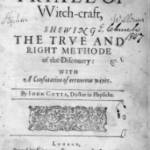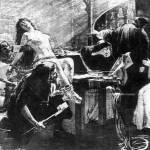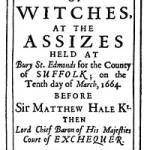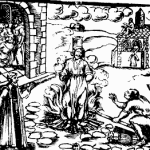All from the twenty-first century:
* Sorcerers stealing or shrinking men’s penises in Congo.
* Black magic murders in Brazil.
* Witches beaten and humiliated in in southern India.
* God punishes Haiti for its witchcraft and other immoralities.
* Though progress in Ghana: a call “for the immediate abolition of witches camps and witchcraft accusations against women and young girls.”
So the Enlightenment and globalization still have work to do — to spread not only free markets and free politics, but the core cognitive principles and practices that enable us to live as free human beings. And it is important to remember that, in cultural time, it was not long ago that many in Europe and North America were still in the grip of superstition and spooky supernaturalism. (Yet the USA may be reverting to pre- and anti-Enlightenment sub-cultures: “Why Witchcraft Is on the Rise” in year 2020).)
Here is a classic example from 1587. In that year, Michelangelo had been dead for 23 years and Galileo was 23 years old, but the Europe that could produce artists and scientists on that scale could still persecute women like Walpurga Hausmännin for witchcraft.
The Judgment of a Witch
FUGGER NEWS-LETTER

THE HEREIN mentioned, malefic and miserable woman, Walpurga Hausmännin, now imprisoned and in chains, has, upon kindly questioning and also torture, following on persistent and fully justified accusations, confessed her witchcraft and admitted the following. When one-and-thirty years ago she had become a widow, she cut corn for Hans Schlumperger, of this place, together with his former servant, Bis im Pfarrhof by name. Him she enticed with lewd speeches and gestures, and they convened that they should, on an appointed night, meet in her, Walpurga’s, dwelling, there to indulge in lustful intercourse. So when Walpurga in expectation of this sat awaiting him at night in her chamber, meditating upon evil and fleshly thoughts, it was not the said bondsman who appeared unto her, but the Evil One in the latter’s guise and raiment and indulged in fornication with her. Thereupon he presented her with a piece of money, in the semblance of half a thaler, but no one could take it from her, for it was a bad coin and like lead. For this reason she had thrown it away. After the act of fornication she saw and felt the cloven foot of her whore-monger, and that his hand was not natural, but as if made of wood. She was greatly affrighted thereat and called upon the name of Jesus, whereupon the Devil left her and vanished.
On the ensuing night the Evil Spirit visited her again in the same shape and whored with her. He made her many promises to help her in her poverty and need, wherefore she surrendered herself to him body and soul. Thereafter the Evil One inflicted upon her a scratch below the left shoulder, demanding that she should sell her soul to him with the blood that had flowed therefrom. To this end he gave her a quill and, whereas she could not write, the Evil One guided her hand. She believes that nothing offensive was written, for the Evil One only swept with her hand across the paper. The script the Devil took with him, and whenever she piously thought of God Almighty, or wished to go to church, the Devil reminded her of it.

Further, the above-mentioned Walpurga confesses that she oft and much rode on a pitchfork by night with her paramour, but not far, on account of her duties. At such devilish trysts she met a big man with a grey beard, who sat in a chair, like a great prince, and was richly attired. That was the Great Devil to whom she had once more dedicated and promised herself body and soul. Him she worshipped and before him she knelt, and unto him she rendered other suchlike honours. But she pretends not to know with what words and in which fashion she prayed. She only knows that once she heedlessly pronounced the name of Jesus. Then the above-mentioned Great Devil struck her in the face and Walpurga had to disown (which is terrible to relate) God in heaven, the Christian name and belief, the blessed saints and the Holy Sacraments, also to renounce the heavenly hosts and the whole of Christendom. Thereupon the Great Devil baptized her afresh, naming her Höfelin, but her paramour-devil, Federlin oft received the Blessed Sacrament of the true Body and Blood of Jesus Christ, apparently by the mouth, but had not partaken of it, but (which once more is terrible to relate) had always taken it out of her mouth again and delivered it up to Federlin, her paramour. At their nightly gatherings she had oft with her other playfellows trodden underfoot the Holy and Blessed Sacrament and the image of the Holy Cross. The said Walpurga states that during such-like frightful and loathsome blasphemies she at times truly did espy drops of blood upon the said Holy Sacrament, whereat she herself was greatly horrified. . . . She confesses, also, that her paramour gave her a salve in a little box with which to injure people and animals, and even the precious fruit of the field. He also compelled her to do away with and to kill young infants at birth, even before they had been taken to Holy Baptism. This she did, whenever possible. …

She rubbed with her salve and brought about the death of Lienhart Geilen’s three cows, of Bruchbauer’s horse, two years ago of Max Petzel’s cow, three years ago of Dun Striegel’s cow, two years ago of Hans Striegel’s cow, of the cow of the governor’s wife, of a cow of Frau Schötterin, and two years ago of a cow of Michel Klingler, on the village green. In short, she confesses that she destroyed a large number of cattle over and above this. A year ago she found bleached linen on the common and rubbed it with her salve, so that the pigs and geese ran over it and perished shortly thereafter. Walpurga confesses further that every year since she has sold herself to the Devil she has on St. Leonard’s Day exhumed at least one or two innocent children. With her devil-paramour and other playfellows she has eaten these and used their hair and their little bones for witchcraft. She was unable to exhume the other children she had slain at birth, although she attempted it, because they had been baptized before God.
She had used the said little bones to manufacture hail; this she was wont to do once or twice a year. Once this spring, from Siechenhausen, downwards across the fields. She likewise manufactured hail last Whitsun, and when she and others were accused of having held a witches’ revel, she had actually held one near the upper gate by the garden of Peter Schmidt. At that time her playfellows began to quarrel and struck one another, because some wanted to cause it to hail over Dillingen Meadows, others below it. At last the hail was sent over the marsh towards Weissingen, doing great damage. She admits that she would have caused still more and greater evils and damage if the Almighty had not graciously prevented and turned them away.

After all this, the Judges and Jury of the Court of this Town of Dillingen, by virtue of the Imperial and Royal Prerogative and Rights of his Right Reverence, Herr Marquard, bishop of Augsburg, and provost of the Cathedral, our most gracious prince and lord, at last unanimously gave the verdict that the aforesaid Walpurga Hausmännin be punished and dispatched from life to death by burning at the stake as being a maleficent and well-known witch and sorceress, convicted according to the context of Common Law and the Criminal Code of the Emperor Charles V and the Holy Roman Empire. All her goods and chattels and estate left after her to go to the Treasury of our most high prince and lord. The aforesaid Walpurga to be led, seated on a cart, to which she is tied, to the place of her execution, and her body first to be torn five times with red-hot irons. The first time outside the town hail in the left breast and the right arm, the second time at the lower gate in the right breast, the third time at the mill brook outside the hospital gate in the left arm, the fourth time at the place of execution in the left hand. But since for nineteen years she was a licensed and pledged midwife of the city of Dilhingen, yet has acted so vilely, her right hand with which she did such knavish tricks is to be cut off at the place of execution. Neither are her ashes after the burning to remain lying on the ground, but are thereafter to be carried to the nearest flowing water and thrown thereinto. Thus a venerable jury have entrusted the executioner of this city with the actual execution and all connected therewith.
[From The Fugger News-Letters, ed. Victor von Klarwell, trans. P. de Chary (London: John Lane, The Bodley Head Ltd., 1924, pp. 259-262). Also reprinted in The Portable Renaissance Reader.]
The letter from burgomeister Johannes Junius in the classic compilation of documents on witchcraft (which I quote here) is particularly heartbreaking.
Re: “So the Enlightenment and globalization still have work to do — to spread not only free markets and free politics, but the core cognitive principles and practices that enable us to live as free human beings.” I don’t disagree as such, clearly there’s still “work to do”. But the emphasis here strikes me as odd. It’s thanks to Enlightenment in the broad sense that so much of this hateful superstition has been blanched out of people. Rather than say that Enlightenment still has work to do, why not say for example that the mainstream religions still have massive work to do, since persecution linked to witchcraft accusation is almost universally found in connection with various Christian, Islamic and other traditional beliefs? In most places where witchcraft accusation is a serious issue it’s not even necessarily the case that the superstitious beliefs supporting it are found only among a minority of adherents to a mainstream religion; maybe most would say they don’t support the violence, but the actual superstition is believed by large tracts of the population in countries like Nigeria, Pakistan, PNG, etc, and often supported from the pulpit (or equivalent). So how about: “So mainstream religions and establishment religious authorities still have work to do”?